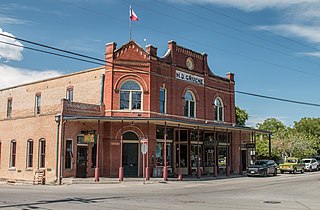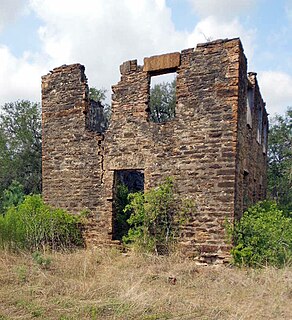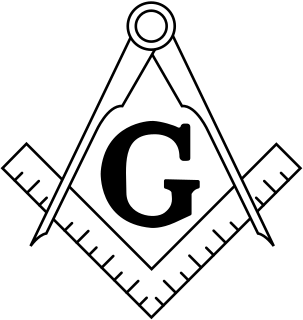
DeWitt County is a county located in the U.S. state of Texas. As of the 2010 census, its population was 20,097. The county seat is Cuero. The county was founded in 1846 and is named for Green DeWitt, who founded an early colony in Texas.

Cuero is a city in DeWitt County, Texas, United States. The population was 6,841 at the 2010 census. It is the county seat of DeWitt County. It is unofficially known as the "turkey capital of the world". In 2010, Cuero was named one of the "Coolest Small Towns in America" by Budget Travel magazine.

Gruene is a former town in Comal County in the U.S. state of Texas. Once a significant cotton-producing community along the Guadalupe River, the town has now shifted its economy to one supported primarily by tourism. Gruene is now a district within the city limits of New Braunfels, and much of it was listed in the National Register of Historic Places on April 21, 1975. It is part of the San Antonio-New Braunfels Metropolitan Area.
Greenwood is an unincorporated community in Wise County, Texas, United States.

Huckabay is an unincorporated community located at the intersection of State Highway 108 and Farm Road 219, ten miles northwest of Stephenville in Erath County, Texas, United States. It had a population of approximately 3 in 1990.

Meyersville is an unincorporated community in DeWitt County, Texas, United States.
Lebanon was the name of two different communities that were founded in Texas in the 19th Century, neither of which exists today. The first was a town located in Collin County that had a post office designated as Lebanon, Texas, before it was relocated to Frisco, Texas. The second was a smaller unincorporated community located in Live Oak County of which only a cemetery remains today.

Carlton is an unincorporated community located in Hamilton County in Central Texas. It lies in the northeastern part of the county and has an estimated population of 70.

Monthalia is a small unincorporated rural community in Gonzales County, Texas. The community had only 65 people as of the 2000 census. It is primarily home to livestock ranchers and has no schools or businesses. As a testament to its livestock ranching, Nolan Ryan Beef operates several ranches in the area raising cattle. It is located 14 miles (23 km) from Gonzales, Texas.

Thomaston is an unincorporated community in southeastern DeWitt County, Texas, United States. It lies along U.S. Route 87 southeast of the city of Cuero, the county seat of DeWitt County. Its elevation is 161 feet (49 m). Although Thomaston is unincorporated, it has a post office, with the ZIP code of 77989.
Flomot is an unincorporated community in Motley County, Texas, United States. According to the Handbook of Texas, the community had an estimated population of 181 in 2000.
Comyn is an unincorporated community located in Comanche County in Central Texas. Comyn is located in the east-northeastern part of the county along Farm-to-Market (FM) 1496 and the Fort Worth and Western Railroad.
Royston is a ghost town in northeastern Fisher County, Texas, United States, 10 miles (16 km) northeast of Roby. Historical Marker at Royston site: It was founded in 1907, and had a population of 500 in 1909. That figure declined to 75 by 1940, 30 in 1980 and 1990, and no figures were available by 2000. Royston Townsite - The town of Royston came into existence in 1906, when the Texas Central Railroad built a line through this area. In addition to the railroad depot, homes and businesses were soon established in the new town. The Royston Post Office was established in 1907. Businesses included a 30-room hotel, the "Royston Record" weekly newspaper, the Royston Mercantile Company, the Royston State Bank, a cotton gin, tin shop, grocery and hardware store, drug store, restaurant, and two lumberyards. A public school was in operation until 1947, when it was consolidated with McCaulley School. Churches in the town included Methodist, Baptist, and Pentecostal. The center of a rich agricultural area, Royston's economic base was broadened after the discovery of oil in the area in 1928. The railroad continued both freight and passenger service until 1972, and Royston was an important supply center for the surrounding agricultural area for a number of years. The town of Royston gradually declined, and the rails were removed by the railroad company. This site marks the approximate southern boundary of the town square. Now a ghost town, it is nevertheless an important part of Fisher County history.

Benton City is a ghost town in Atascosa County, Texas, United States, sometimes also called Benton, located on Benton City Road along Atascosa Creek, 3 miles east of present-day Lytle, 27 miles southwest of San Antonio.
Aurora Estrada Orozco was a Mexican American community leader and writer.

Cuthbert is a ghost town in Mitchell County, Texas, United States. Cuthbert was established in 1890 when the founder D. T. Bozeman built a wagonyard and store. The community and post office were named for Thomas Cuthbertson, a family friend of the Bozemans. By the early 1920s, Cuthbert had a church, two stores, a blacksmith shop, a cotton gin, telephone office, and a school. Today, only a cemetery and a few scattered farms remain.
Polonia was a small rural community located in northwest Caldwell County. The ghost town is 6 miles northwest of Lockhart, Texas.
Gasoline is a ghost town in Briscoe County, Texas.
String Prairie is an unincorporated community in Bastrop County, Texas, United States. Located on Texas State Highway 304, the town is 5 miles (8.0 km) southwest of Rosanky and 45 miles (72 km) southeast of Austin.
Hills Prairie, or Hill's Prairie, is an unincorporated community in Bastrop County, Texas, United States. It is located off Farm to Market Road 304, eight miles southeast of the town of Bastrop, 8 miles northwest of Smithville and 40 miles southeast of Austin.
















